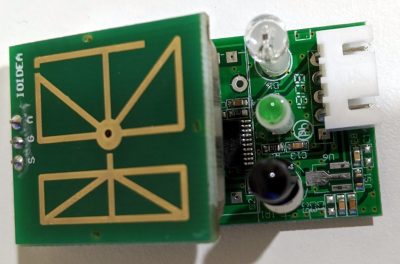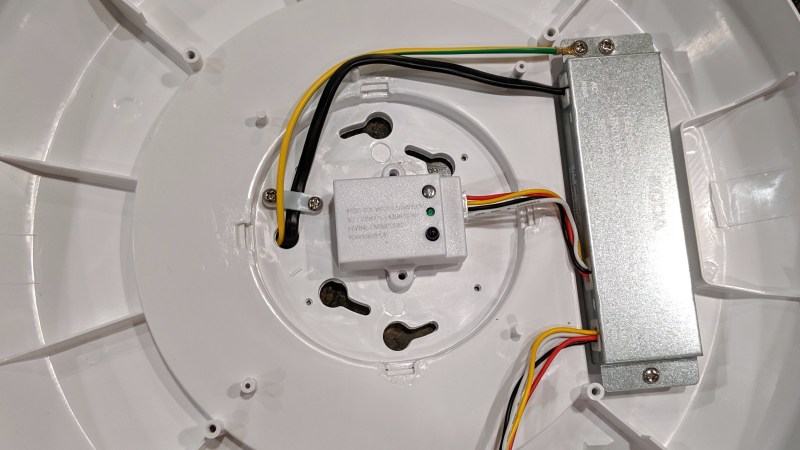[hclxing] eagerly picked up an LED ceiling light for its ability to be turned on and off remotely, but it turns out that the lamp has quite a few other features. These include adjustable brightness, color temperature, automatic turnoff, light sensing, motion sensing, and more. Before installing, [hclxing] decided to tear it down to see what was involved in bringing all those features to bear, but after opening the lamp there wasn’t much to see. Surprisingly, besides a PCB laden with LEDs, there were exactly two components inside the unit: an AC power adapter and a small white controller unit. That’s it.

The power adapter is straightforward in that it accepts 100-240 Volts AC and turns it into 30-40 Volts DC for the LEDs, and it appears to provide 5 V for the controller as well. But [hclxing] noticed that the small white controller unit — the only other component besides the LEDs — had an FCC ID on it. A quick bit of online sleuthing revealed that ID is attached to a microwave sensor module. Most of us would probably expect to see a PIR sensor, but this light is motion sensing with microwaves. We have seen such units tested in the past, which links to a video [hclxing] also references.
The microwave motion sensor board is shown here, and underneath it is a dense PCB that controls all other functions. Once [hclxing] identified the wires and their signals, it was off to Costco to buy more because the device looks eminently hackable. We’re sure [hclxing] can do it, given their past history with reverse-engineering WyzeSense hardware.
















I work for a lighting company. When these came out I bought one, tested it and tore it down.
1) It doesn’t come close to the specs it claims.
2) It draws a considerable amount of power when “off”. I forget how much, but way past that allowed by Title 24.
The microwave detector thing was essentially not adjustable in range, leading to it turning on when something moved in an adjacent room.
It also knocks out all WiFi in the room whenever it’s receiving power. I installed 3 of these and had to return all of them. I wonder if I could have fixed them by ripping out the motion sensor?
They probably put out more power than your microwave oven’s leakage. They’ll work fine outside probably (mine does), but use only PIR sensors indoors near wifi gizmos.
I’m a bit of a novice but what is Title 24?
But a couple of dozen. Make an array. Do a bit of Fourier magic and you can see through walls. Not that this hasn’t been done before with wifi.
That’s interesting! I haven’t heard of this before. What might I google to find out more?
Just getting some WAGs looking at that antenna, kinda looks a bit like separated tx and rx antennas, where the tx is spot tuned, and the rx has spot tuned cancellation of center frequency and bowtie style band widening to pick up doppler shifted reflections. But you know what they say, RF design sufficiently advanced up the frequency scale is indistinguishable from magic.
The first RF motion detector I tore down was around 1965. It used a tube, and the UHF band somewhere. Anybody wandering around would change the current drawn by the oscillator, because they detuned the circuit a bit.
The microwave LED light I bought recently works the same way (Big Clive tore one down). You don’t rely on a return signal like a real radar, you’re changing the loading of the oscillator. You don’t get any range measurement capability, it’s just a matter of distance vs. size that perturbs the field.
I’m not fully satisfied with the detection of the light; it doesn’t trip when I drive up in the car yet goes on when a bird or rabbit goes near it, or I open a door inside the garage 20 feet away. Just the way the antenna is aimed inside I guess.
It doesn’t take a lot of power, but a PIR sensor would take a lot less.
“The first RF motion detector I tore down was around 1965. It used a tube, and the UHF band somewhere. Anybody wandering around would change the current drawn by the oscillator, because they detuned the circuit a bit.”
You mean like a Theremin?
A Theremin uses two oscillators beating against each other. You control the beat note by tuning one of the oscillators with your hand.
Usable in a following distance hack for a vehicle cruise control? I’d love such an addon for when I’m behind a person wo cannot hold a steady speed.
When? That seems like everybody these days.
Probably not, I definitely wouldn’t trust this at least. You might be better off with laser rangefinding if you want something simple. I would not want to set this up in my car.
Buy a car with adaptive cruise control. Like a lot of engineering, the concept is simple but the details require a lot of tuning and testing.
And possibly the greatest HaD fail of all time. Neither HaD nor last year’s writeup had anything resembling a referral link. NOt even a product link that I saw in my 20 second once over
Is the remote RF? Assuming so, could the RF module be a remote control interface?
In the photo, the purple-blue colored thing in the lower right is probably an IR detector.
Somewhat related but a different product from Costco: I but 6 KODA linkable LED lights thinking that I can disable the sensors on all but 1 and use that as the source of light control. Unfortunately they are only linkable via the AC power thus when all are linked together in close(12”) proximity, the remote control doesn’t always control all lamps. Do you by any chance have access to a schematic for this lamp? Model no. is LM030008. I probably can hack through it but a schematic would make it easier. Thank you.